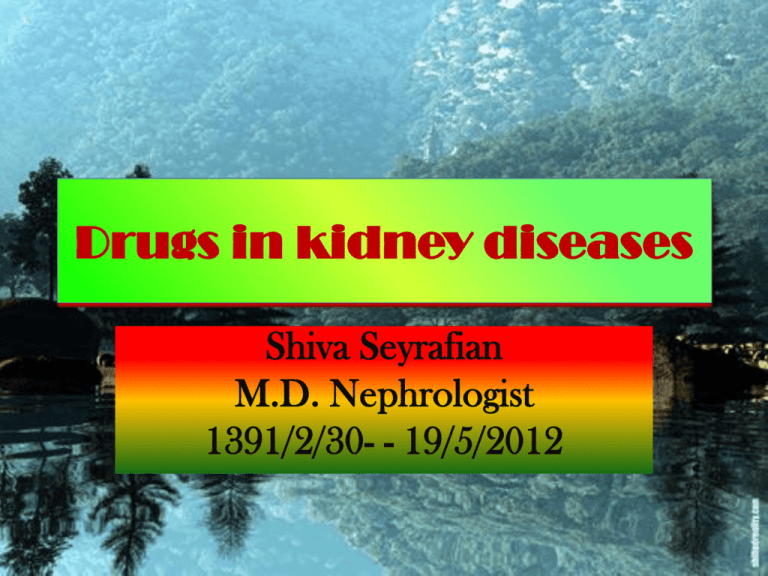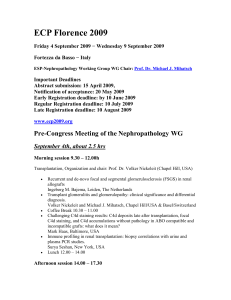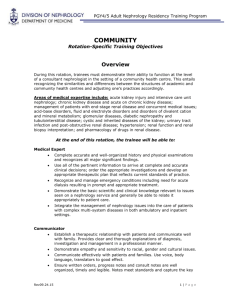Drugs in kidney diseases
advertisement

Drugs in kidney diseases Shiva Seyrafian M.D. Nephrologist 1391/2/30- - 19/5/2012 Drugs and the Kidney 1. 2. 3. 4. Drugs and the normal kidney Drugs toxic to the kidney Prescribing in kidney disease Case presentation Normal Kidney Function • • • • • • • 1 Extra Cellular Fluid Volume control 2 Electrolyte balance 3 Waste product excretion 4 Drug and hormone elimination/metabolism 5 Blood pressure regulation 6 Regulation of haematocrit 7 regulation of calcium/phosphate balance (vitamin D3 metabolism) Pharmacokinetics • • • • Absorption Distribution Metabolism Elimination – filtration – secretion Drugs and normal kidney Effects of renal disease on drugs Patient –related risk factors for drug-induced nephrotoxicity Absolute or effective intravascular depletion Age older than 60 years Diabetes Exposure to multiple nephrotoxins Heart failure Sepsis Underlying renal insufficiency (glumerular filtration rate <60 ml per minute per 1.73m2) Drugs toxic to the kidney Amphotericin B Cisplatin Crystal-induced Ifosfamide Lead, mercury, cadmium Analgesics, NSAIDs Lithium Triamterene Amphotericin B nephrotoxicity Increase in serum creatinine occurs in 5-80% patients, manifestations include renal insufficiency, urinary potassium wasting and hypokalemia, urinary magnesium wasting and hypomagnesemia, metabolic acidosis due to type 1 (or distal) renal tubular acidosis, and polyuria due to nephrogenic diabetes insipidus. Risk factors: aminoglycosides, cyclosporine, non- lipid based(liposomal amphotericin B), hypovolemia. Nephrotoxicity is usually reversible with discontinuation of therapy. Recurrent renal dysfunction can occur if treatment is reinstituted. Crystal-induced acute kidney injury (acute renal failure) Acute Uric Acid Nephropathy, Intravenous Acyclovir, (prior hydration (with the urine output maintained above 75 mL/h) and slow drug infusion over 1 to 2 hours) Oral therapy is also well tolerated Sulfonamide Antibiotics, (fluid intake above three liters per day, monitoring the urine for crystals, and, if crystals are seen, alkalinization of the urine to a pH above 7.15 ) Ethylene Glycol, Megadose Vitamin C, Crystal-induced acute kidney injury (acute renal failure) Methotrexate nephrotoxicity: with an acidic urine (since MTX is poorly soluble in an acidic urine), and with volume depletion . Prevention: alkalinization of the urine to a pH above 7.0, three liters per day of dextrose in water to which 44 to 66 meq/L of sodium bicarbonate has been added, begun 12 hours before MTX administration and continuing for 24 to 48 hours. The acute renal failure induced by methotrexate is reversible in almost all cases. The plasma creatinine concentration usually peaks within the first week and returns well toward baseline levels within one to three weeks , Leucovorin rescue Indinavir: nephrolithiasis (nonopaque stones ), tubulointerstitial nephritis , 150 mL/h in the three hours after each oral dose of indinavir should minimize the risk of crystal formation . Patients are asymptomatic or may have flank pain, hematuria, pyuria and crystaluria. Sulfonamide crystals Indinavir sulfate urinary crystals NSAIDs Acute kidney injury (acute renal failure) and nephrotic syndrome ; NSAIDs can induce two different forms of acute kidney injury: 1-hemodynamicallymediated (ATN); and 2-acute interstitial nephritis, which is often accompanied by the nephrotic syndrome (membranous or minimal change disease). The former and perhaps the latter are directly related to the reduction in prostaglandin synthesis induced by the NSAID. NSAIDs … Low-dose aspirin (studied at approximately 40 mg per day), low-dose over-the-counter ibuprofen, and perhaps sulindac appear to be safer; however even low dose ibuprofen can reduce the glomerular filtration rate in patients with reduced renal perfusion . Patients who present with acute interstitial nephritis typically present with hematuria, pyuria, white cell casts, proteinuria, and an acute rise in the plasma creatinine concentration. Spontaneous recovery generally occurs within weeks to a few months after therapy is discontinued. NSAIDs … Chronic kidney disease: daily NSAIDs for prolonged time induce CKD (analgesic nephropathy) due to papillary necrosis. The NSAID-induced inhibition of prostaglandin-mediated afferent vasodilation may increase the risk for acute tubular necrosis (ATN) caused by ischemia or other nephrotoxins, such as radiocontrast media. NSAIDs-Analgesic nephropathy Analgesic nephropathy is characterized by renal papillary necrosis and chronic interstitial nephritis. It is caused by prolonged and excessive consumption of analgesic medications that contain phenacetin, aspirin, acetaminophen, nonsteroidal antiinflammatory agents (NSAIDs), or salicylamide. Aspirin alone (in therapeutic doses) does not appear to induce renal injury but may potentiate the toxicity of phenacetin and acetaminophen. Many small studies have suggested that chronic, especially daily, acetaminophen use has dosedependent, long-term nephrotoxicity. NSAIDs… Aspirin may potentiate the toxicity of phenacetin and acetaminophen by both depleting cortical and papillary glutathione levels, and altering prostaglandin-dependent renal blood flow within the medulla, rendering it more prone to ischemic damage. The effect of long-term use of selective COX-2 inhibitors on kidney function is unknown. NSAIDs … RECOMMENDATIONS: Patients should not take NSAIDs prior to procedures that involve the administration of iodinated contrast media. All NSAIDs, including topically administered forms, should be terminated in patients suspected of having NSAID-induced acute interstitial nephritis. Although there is no definitive evidence that corticosteroid therapy is beneficial in this setting, a course of prednisone may be considered in patients whose renal failure persists more than one to two weeks after the NSAID has been discontinued. Acute Tubular Necrosis Due to ischemia from exposure to toxin. Death of the tube, sloughing of Renal tubules. Caused by: 1. 2. 3. 4. Aminoglycosides Amphotericin B Radiocontrast dye Cisplatin Aminoglycisdes Gentamycin and Kanamycin, Amikacin ◦ Affecting PCT by binding of +ve charges of AG to phospholipids in plasma, mitochondria and lysosomal membranes. It will interfere in the functions of organelles. ◦ Renal toxicity appears 5-10 days of treatment by monitoring serum creatinine. ◦ AKI is reversible Aminoglycosides Highly effective antimicrobials ◦ Particularly useful in gram -ve sepsis ◦ bactericidal BUT ◦ Nephrotoxic ◦ Ototoxic ◦ Narrow therapeutic range Prescribing Aminoglycosides Once daily regimen now recommended in patients with normal kidneys High peak concentration enhances efficacy long post dose effect Single daily dose less nephrotoxic Dose depends on size and renal function Measure levels! Contrast-induced Nephropathy Type of contrast agent: 1. Ionic or nonionic agents 2. High or low or iso osmolal agents: 1400-1800 (iohexol) vs. 500- 850 vs. 290 mOsm/Kg : Iodixanol The primary benefit of nonionic contrast agents, whether low or iso-osmolal, is seen in high-risk patients (eg, serum creatinine ≥1.5 mg/dL [132 micromol/L] or a GFR <60 mL/min per 1.73 m2), particularly if they are diabetic. As a result, these agents should be used instead of ionic high osmolal agents. contrast-induced nephropathy Gadolinium has been considered to carry low or no risk of nephrotoxicity. However, there are some reports of reversible acute renal failure, particularly in patients with significant renal dysfunction. Pathogenesis of contrast: renal vasoconstriction, ATN contrast-induced nephropathy Incidence: zero to over 50 percent Acute renal failure, defined as an increase in plasma creatinine of more than 0.5 mg/dL (44 micromol/L) above baseline. Risk factors: 1. Underlying renal insufficiency, with the plasma creatinine exceeding 1.5 mg/dL (132 micromol/L) or, although not measured clinically, the GFR being less than 60 mL/min per 1.73 m2 2. Diabetic nephropathy with renal insufficiency 3. Advanced heart failure or other cause of reduced renal perfusion (such as hypovolemia) 4. Percutaneous coronary intervention, which also promotes the development of atheroemboli 5. High total dose of contrast agent 6. Multiple myeloma (with older contrast agents) Contrast-induced nephropathy Contrast nephrotoxicity is dose dependent and lower dose is safer. Low dose has been variably defined as less than 70 mL, less than 125 mL, or less than 5 mL/kg [to a maximum of 300 mL] divided by the plasma creatinine concentration. However, diabetic patients with a plasma creatinine concentration above 5 mg/dL (440 micromol/L) may be at risk from as little as 20 to 30 mL of contrast Contrast-induced nephropathy CLINICAL CHARACTERISTICS: The renal failure induced by contrast agents begins within the first 12 to 24 hours after the contrast study. The renal failure is nonoliguric for the vast majority of patients. In almost all cases, the decline in renal function is mild and transient, with recovery of renal function typically beginning within three to five days. contrast-induced nephropathy prevention: Hydration, mannitol, and diuretics — Hydration is beneficial, and the type of hydration solution may be important. In comparison, the role of diuretics, mannitol and other renal vasodilators in this setting is uncertain. We recommend NOT using mannitol or other diuretics prophylactically. contrast-induced nephropathy Prevention The use, if clinically possible, of ultrasonography, magnetic resonance imaging or CT scanning without radiocontrast agents, particularly in high-risk patients. The use of lower doses of contrast and avoidance of repetitive studies that are closely spaced (within 48 to 72 hours). Very small amounts of contrast (<10 mL) have been safely used in patients with advanced kidney disease for examination of poorly maturing arteriovenous fistula. Avoidance of volume depletion or nonsteroidal antiinflammatory drugs, both of which can increase renal vasoconstriction. The administration of intravenous saline or possibly sodium bicarbonate. The administration of the antioxidant acetylcysteine. The use of selected low or iso-osmolal nonionic contrast agents. contrast-induced nephropathy Prevention bolus of 3 mL/kg of isotonic bicarbonate for one hour prior to the procedure, and continued at a rate of 1 mL/kg per hour for six hours after the procedure. This solution can be prepared by adding 150 meq of sodium bicarbonate (three 50 mL ampules of 1 meq/mL sodium bicarbonate) to 850 mL of sterile water. It is not recommended routine use of prophylactic hemodialysis for removal of contrast in stage 3 or 4 of CKD; and for stage 5 it is considered when there is a vascular access. Contrast-enhanced MRI There are two major concerns: Among patients with moderate and particularly severe renal failure, the possible development of the severe syndrome of nephrogenic systemic fibrosis. The possible development of nephrotoxicity, similar to that seen with iodinated contrast agents. Contrast-enhanced MRI Gadolinium-based imaging should not be performed, if at all possible, in patients with an estimated glomerular filtration rate less than 30 mL/min because of the risk of nephrogenic systemic fibrosis. In such patients, we prefer the risk of radiocontrast nephropathy with iodinated contrast media, using all of the preventive measures that are available, to the risk of the much more severe complication of NSF. Chemotherapy-related nephrotoxicity Chemotherapy can cause nephrotoxicity by a variety of different mechanisms. Factors can potentiate renal dysfunction: 1. Intravascular volume depletion, 2. The concomitant use of nonchemotherapeutic nephrotoxic drugs (eg, aminoglycoside antibiotics, nonsteroidal antiinflammatory drugs) or 3. Radiographic ionic contrast media in patients with or without preexisting renal dysfunction, 4. Tumor-related urinary tract obstruction, and 5. Intrinsic renal disease. Chemotherapy-related nephrotoxicity Dose adjustment in this setting is typically based upon two factors: an estimation of glomerular filtration rate (GFR), which serves as an index of the number of functioning nephrons, and evaluation of clinical signs of drug toxicity (eg, neutropenia, thrombocytopenia). Chemotherapy agents that may require dose reduction in patients with renal insufficiency Arsenic trioxide Eribulin Oxaliplatin Bleomycin Etoposide Pentostatin Capecitabine Fludarabine Pemetrexed Carboplatin Hydroxyurea Sorafenib Cisplatin Ifosfamide Streptozocin Cladribine Irinotecan Topotecan Cyclophosphamide Lenalidomide Vandetanib Cytarabine (high dose) Lomustine Daunorubicin Melphalan Epirubicin Methotrexate Mitomycin Triamterene nephrotoxicity Triamterene is a potential nephrotoxin, frequently inducing crystalluria and cast formation, and rarely causing stone formation or reversible acute renal failure. The excretion of triamterene crystals and granular casts occurs in as many as one-half of patients. this finding is not seen with amiloride. Triamterene may contribute to 1 in every 200 to 250 stones. Reversible acute renal failure is another rare problem with triamterene (but not other potassiumsparing diuretics). Two different mechanisms have been described: intratubular obstruction by crystals; and concurrent therapy with a NSAID. Lead nephropathy and lead-related nephrotoxicity High level of lead exposure required to cause lead nephropathy is now increasingly rare, particularly in developed countries, due to occupational controls and removal of lead from paint, gasoline, and other environmental sources. Cortical bone lead reflects cumulative lead exposure and the potential for endogenous exposure since bone lead is mobilizable into the circulation . Cortical bone lead is measured by xray fluorescence (XRF) in the mid-shaft of the tibia. The half-life is estimated to be 10 to 30 years. lead exposure may be associated with both hypertension and increased cardiovascular risk. Lead nephropathy and lead-related nephrotoxicity Manifestations: Chronic interstitial nephritis, is a potential complication of prolonged (5 to 30 years), high-level lead exposure. Fanconi- type syndrome 2- azotemia, hyperuricemia and gout due to more prolonged exposure. Treatment: Acute renal failure was noted in reports from the early 1980s of calcium EDTA therapy given at high doses Lead nephropathy and lead-related nephrotoxicity Diagnosis-Lead may be measured in whole blood, bone, and, following administration of a chelating agent, urine. If the blood lead level is greater than 10 mcg/dL (0.48 micromol/L), levels should be rechecked four weeks after the identified source of lead exposure is eliminated. Treatment — Minimizing further exogenous lead exposure Chelation therapy: calcium EDTA three times weekly for 6 to 50 months; Effect of dialysis on drugs Drugs with MW >500 daltons poorly cleared by conventional HD membranes. Protein or tissue binding or lipid soluble are not dialyzed properly. For drugs not removed by HD, it is unusual to be removed by peritoneal dialysis. High-flux membranes (porous) are more permeable to drugs. TABLE 57-2 -- Drugs That Have Active or Toxic Metabolites in Dialysis Patients Acetaminophen Angiotensin-converting enzyme inhibitors Angiotensin receptor blockers Adriamycin Allopurinol Amiodarone Amoxapine Azathioprine Benzodiazepines β-Blockers Bupropion Buspirone Cardiac glycosides Clorazepate Cephalosporins Chloral hydrate Clofibrate Desipramine Diltiazem Encainide Esmolol H2-blockers Hydroxyzine Imipramine TABLE 57-2-- Drugs That Have Active or Toxic Metabolites in Dialysis Patients cont….. Isosorbide Levodopa Lorcainide Meperidine Metronidazole Methyldopa Miglitol Minoxidil Morphine Nitrofurantoin Nitroprusside Procainamide Primidone Propoxyphene Pyrimethamine Quinidine Serotonin reuptake inhibitors Spironolactone Sulfonylureas Sulindac Thiazolidinediones Triamterene Trimethadione Verapamil Vidarabine B & C- ACEIs and ARB ◦ Angiotensin converting enzyme inhibitors (ACEI) and angiotensin receptor blocker (ARB) are inhibiting Renin system and decrease the blood hemodynamic: It produces VD and decrease perfusion pressure and decreases GF At the start of the treatment a decrease of urine volume and increase of creatinine by 30% indicates Damage is reversible Rehydration of patient is advisable Initiate treatment with short acting (captopril) and titrate later with long acting Glomerulonephritis 4 Different immunological drug induced GN: 1. Nephrotic syndrome: NSAID, ampicillin, rifampicin and lithium 2. Focal segmental glomeruloscerosis (FSGS): lithium, heroin 3. Membrane nephropathy (MN): NSAID, gold therapy, mercury, penicillamine 4. Membranoproliferative: hydralazine Dosing in renal impairment Loading dose does not change (usually) Maintenance dose or dosing interval does T ½ often prolonged ◦ Reduce dose OR ◦ Increase dosing interval ◦ Some drugs have active metabolites that are themselves excreted renally Warfarin, diazepam References Clinical Pharmacology: Melmon and Morrelli, McGraw-Hill, 2000 Taber SS and Pasko, Epidemiology of druginduced disorders: the kidney; Exper.Opin.Drug Saf. 7(6):679-690, 2008 Hanbook of dialysis therapy: Nissenson and Fine, Sunders Elsevier, philadelphia, 4th edition, 2008, (83): 1089-1195 The Kidney at a glance: O’callaghan and Brenner, blackwell Science,2000:38-39 Burton Rose, drug-induced nephrotoxicity, Uptodate 20.1 2012 case1 A 54 y/o female with resistant ALL received IV Methotraxate for 3 days. After 3-4 days she developed nausea, vomiting and azotemia was diagnosed. She had hypocalcemia, hyperphosphatemia hyperuricemia and hyperkalemia. In lab exam also severe keukopenia and pancytopenia was found. She received G-CSF, leukoverin, Hemodialysis and Antibiotics. Dx? case2 A 65 y/o female with chronic hypertension developed fever 39 ºc and dysuria, flank pain. In U/A and U/C pyuria and E-Coli 100000 cc was reported. She received 500 mg amikacin stat and 250 mg tid IM. Her serum Cr was 1.5 mg/dl and BUN 26, her body weight was 50 kg. What is your opinion about this prescription? Case2… Cr Clearance= (140-age)x BW (kg)/85 x serum Cr Cr Clearance= 75 x 50/85 x 1.5 Cr Clearance= 3750 / 127.5 Cr Clearance= 30 ml/min What is your prescription? Case3 A 38 y/o man with uncontroled hypertension and serum Cr = 2 mg/dl and BUN 28 mg/dl is candidate for renal artery MRA with gadolinium, his BW is 72 kg. What is your opinion? Could he do the MRA? What is his estimated GFR? Case3… Cr Clearance= (140-age)x BW (kg)/85 x serum Cr Cr Clearance= 140 – 38 x 72/72 x 2 Cr Clearance= 102x 72/ 144 Cr Clearance= 51ml/min case4 A 47 y/o diabetic male with IHD and Chest pain is candidate for coronary angiography; his serum Cr is 2.5 mg/dl and BW is 85kg . He is consulted for using contrast. What is your suggestion? Can he use contrast? Does he need prophylctic dialysis?







